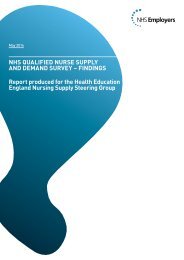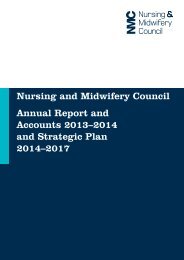Journal_1_2014_final_WEB
Journal_1_2014_final_WEB
Journal_1_2014_final_WEB
Create successful ePaper yourself
Turn your PDF publications into a flip-book with our unique Google optimized e-Paper software.
Cochrane Reviews<br />
ABSTRACTS OF RECENT<br />
COCHRANE REVIEWS<br />
Dressings and topical agents for<br />
preventing pressure ulcers<br />
Zena EH Moore, Joan Webster<br />
Moore ZEH, Webster J. Dressings and topical agents<br />
for preventing pressure ulcers. Cochrane Database of<br />
Systematic Reviews 2013, Issue 8. Art. No.:<br />
CD009362. DOI: 10.1002/14651858.CD009362.<br />
pub2.<br />
Copyright © 2013 The Cochrane Collaboration.<br />
Published by John Wiley & Sons, Ltd.<br />
ABSTRACT<br />
Background: Pressure ulcers, which are localised injury<br />
to the skin, or underlying tissue or both, occur when<br />
people are unable to reposition themselves to relieve<br />
pressure on bony prominences. Pressure ulcers are<br />
often difficult to heal, painful and impact negatively on<br />
the individual’s quality of life. The cost implications of<br />
pressure ulcer treatment are considerable, compounding<br />
the challenges in providing cost effective, efficient<br />
health services. Efforts to prevent the development of<br />
pressure ulcers have focused on nutritional support,<br />
pressure redistributing devices, turning regimes and the<br />
application of various topical agents and dressings<br />
designed to maintain healthy skin, relieve pressure and<br />
prevent shearing forces. Although products aimed at<br />
preventing pressure ulcers are widely used, it remains<br />
unclear which, if any, of these approaches are effective<br />
in preventing the development of pressure ulcers.<br />
Objectives: To evaluate the effects of dressings and<br />
topical agents on the prevention of pressure ulcers, in<br />
people of any age without existing pressure ulcers, but<br />
considered to be at risk of developing a pressure ulcer,<br />
in any healthcare setting.<br />
Search methods: In February 2013 we searched the<br />
following electronic databases to identify reports of relevant<br />
randomised clinical trials (RCTs): the Cochrane<br />
Wounds Group Specialised Register; the Cochrane<br />
Central Register of Controlled Trials (CENTRAL)<br />
(The Cochrane Library); Database of ABSTRACTs of<br />
Reviews of Effects (The Cochrane Library);<br />
Ovid MEDLINE; Ovid MEDLINE (In-Process & Other<br />
Non-Indexed Citations); Ovid EMBASE; and EBSCO<br />
CINAHL.<br />
Selection criteria: We included RCTs evaluating the<br />
use of dressings, topical agents, or topical agents with<br />
dressings, compared with a different dressing, topical<br />
agent, or combined topical agent and dressing, or no<br />
intervention or standard care, with the aim of preventing<br />
the development of a pressure ulcer.<br />
Data collection and analysis: We assessed trials for<br />
their appropriateness for inclusion and for their risk of<br />
bias. This was done by two review authors working<br />
independently, using pre-determined inclusion and<br />
quality criteria.<br />
Main results: Five trials (940 participants) of unclear or<br />
high risk of bias compared a topical agent with a placebo.<br />
Four of these trials randomised by individual and<br />
one by cluster. When results from the five trials were<br />
combined, the risk ratio (RR) was 0.78 (95% CI 0.47<br />
to 1.31; P value 0.35) indicating no overall beneficial<br />
effect of the topical agents. When the cluster randomised<br />
trial was omitted from the analysis, use of topical<br />
agents reduced the pressure ulcer incidence by<br />
36%; RR 0.64 (95% CI 0.49 to 0.83; P value 0.0008).<br />
Four trials (561 participants), all of which were of high<br />
or unclear risk of bias, showed that dressings applied<br />
over bony prominences reduced pressure ulcer incidence;<br />
RR 0.21 (95% CI 0.09 to 0.51; P value<br />
0.0006).<br />
Authors’ conclusions: There is insufficient evidence<br />
from RCTs to support or refute the use of topical<br />
agents applied over bony prominences to prevent pressure<br />
ulcers. Although the incidence of pressure ulcers<br />
was reduced when dressings were used to protect the<br />
skin, results were compromised by the low quality of<br />
the included trials. These trials contained substantial<br />
risk of bias and clinical heterogeneity (variations in<br />
populations and interventions); consequently, results<br />
should be interpreted as inconclusive. Further well<br />
designed trials addressing important clinical, quality of<br />
life and economic outcomes are justified, based on the<br />
incidence of the problem and the high costs associated<br />
with pressure ulcer management.<br />
Plain language summary:<br />
Dressings or topical agents for preventing pressure<br />
ulcers<br />
Pressure ulcers, sometimes known as bedsores or pressure<br />
sores, commonly occur in people who cannot, or<br />
find it difficult to, move themselves. Pressure ulcers are<br />
hard to heal, so it is important to try to prevent them<br />
from occurring in the first place. Various cream and<br />
lotions (topical agents) have been used for this purpose;<br />
the idea is that pressure ulcers are less likely to<br />
occur when the skin is healthy and nourished. A number<br />
of different types of dressings are also used to pro-<br />
<br />
Sally Bell-Syer, MSc<br />
Managing Editor<br />
Cochrane Wounds Group<br />
Department of<br />
Health Sciences<br />
University of York<br />
United Kingdom<br />
Correspondence:<br />
sally.bell-syer@york.ac.uk<br />
Conflict of interest: none<br />
EWMA <strong>Journal</strong> <strong>2014</strong> vol 14 no 1 71




